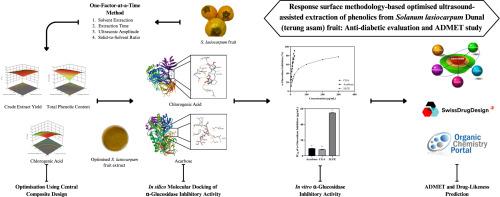Response surface methodology-based optimised ultrasound-assisted extraction of phenolics from Solanum lasiocarpum Dunal (terung asam) fruit: Anti-diabetic evaluation and ADMET study
IF 3.8
Q2 BIOTECHNOLOGY & APPLIED MICROBIOLOGY
引用次数: 0
Abstract
Solanum lasiocarpum Dunal, known as ‘terung asam,’ is an indigenous fruit-vegetable widely cultivated on Borneo Island, particularly in Sarawak (Malaysia) and Kalimantan (Indonesia). This study optimised the ultrasound-assisted extraction of S. lasiocarpum fruit extract (SLFE) using response surface methodology (RSM) and evaluated its anti-diabetic activity. Initial screening with a one-factor-at-a-time (OFAT) approach assessed solvent extraction, extraction time, ultrasonic amplitude, and solid-to-solvent ratio. These parameters were further refined using RSM with a central composite design to optimise crude extract yield (CEY), total phenolic content (TPC), and chlorogenic acid (CGA). Anti-diabetic activity was assessed via in silico molecular docking and in vitro α-glucosidase inhibition. Optimal conditions were an extraction time of 8.93 min, ultrasonic amplitude of 57.00 %, and a solid-to-solvent ratio of 1:29.68 g/mL, resulting in CEY (45.32 ± 0.67 %), TPC (28.22 ± 0.86 mg GAE/g), and CGA (1.78 ± 0.12 mg/g). In silico, CGA demonstrated a higher molecular docking vina score (−7.1 kcal/mol) than acarbose (−6.5 kcal/mol), while in vitro, SLFE exhibited an IC50 of 54.82 ± 0.08 μg/mL, compared to acarbose (9.47 ± 0.13 μg/mL) and CGA (8.15 ± 0.22 μg/mL). These findings establish SLFE as a valuable source of phenolic compounds with significant anti-diabetic activity, suggesting its potential as a food ingredient and dietary supplement.

基于响应面法的超声辅助提取龙骨果中酚类物质的抗糖尿病评价及ADMET研究
Solanum lasiocarpum Dunal,被称为“terung asam”,是婆罗洲岛上广泛种植的一种本土水果蔬菜,特别是在沙捞越(马来西亚)和加里曼丹(印度尼西亚)。本研究利用响应面法(RSM)优化了超声辅助提取枸杞子提取物(SLFE)的工艺条件,并对其抗糖尿病活性进行了评价。初始筛选采用单因素-一次(OFAT)方法评估溶剂萃取、萃取时间、超声波振幅和固溶剂比。采用中心复合设计的RSM进一步优化了这些参数,以优化粗提物得率(CEY)、总酚含量(TPC)和绿原酸(CGA)。通过硅分子对接和体外α-葡萄糖苷酶抑制来评估其抗糖尿病活性。最佳提取条件为提取时间8.93 min,超声振幅为57.00%,料液比为1:29.68 g/mL,得到CEY(45.32±0.67%)、TPC(28.22±0.86 mg GAE/g)和CGA(1.78±0.12 mg/g)。CGA在体外的分子对接静脉评分(- 7.1 kcal/mol)高于阿卡波糖(- 6.5 kcal/mol), SLFE的IC50为54.82±0.08 μg/mL,高于阿卡波糖(9.47±0.13 μg/mL)和CGA(8.15±0.22 μg/mL)。这些发现表明,SLFE是具有显著抗糖尿病活性的酚类化合物的宝贵来源,表明其作为食品成分和膳食补充剂的潜力。
本文章由计算机程序翻译,如有差异,请以英文原文为准。
求助全文
约1分钟内获得全文
求助全文
来源期刊

Biocatalysis and agricultural biotechnology
Agricultural and Biological Sciences-Agronomy and Crop Science
CiteScore
7.70
自引率
2.50%
发文量
308
审稿时长
48 days
期刊介绍:
Biocatalysis and Agricultural Biotechnology is the official journal of the International Society of Biocatalysis and Agricultural Biotechnology (ISBAB). The journal publishes high quality articles especially in the science and technology of biocatalysis, bioprocesses, agricultural biotechnology, biomedical biotechnology, and, if appropriate, from other related areas of biotechnology. The journal will publish peer-reviewed basic and applied research papers, authoritative reviews, and feature articles. The scope of the journal encompasses the research, industrial, and commercial aspects of biotechnology, including the areas of: biocatalysis; bioprocesses; food and agriculture; genetic engineering; molecular biology; healthcare and pharmaceuticals; biofuels; genomics; nanotechnology; environment and biodiversity; and bioremediation.
 求助内容:
求助内容: 应助结果提醒方式:
应助结果提醒方式:


